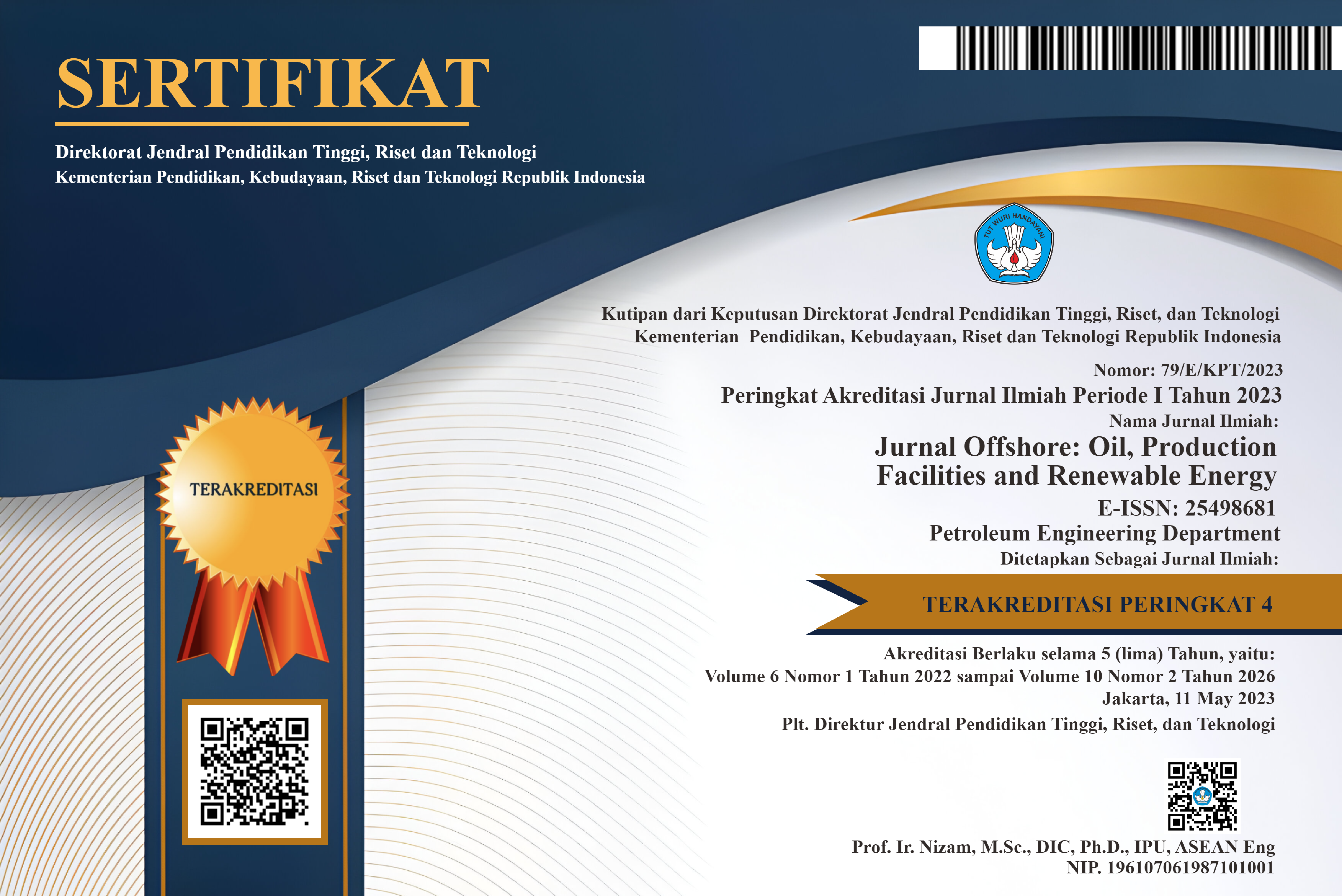Perencanaan Pipa Dua Fasa pada Fasilitas Produksi Panas Bumi Dieng
DOI:
https://doi.org/10.30588/jo.v3i1.492Keywords:
perencanaan, pipa, dua fasa, fasilitas produksi, planning, pipeline, two phase, production facilitiesAbstract
Lapangan Panas Bumi Dieng beroperasi sejak tahun 2004 dengan kapasitas turbin 60 MW serta memiliki target produksi sebesar 55 MW selama tigapuluh tahun. Lapangan ini, masih layak untuk dilakukan pengembangan dengan total sebesar 110 MW. Dalam mengoptimalkan kualitas uap (steam quality) dari kepala sumur sampai dengan input turbin maka perlu adanya perencanan mengenai dimensi dari pipa yang mengalirkan uap. Parameter yang diperhatikan dalam perencanaan pipa dua fasa yaitu diameter pipa dan penurunan tekanan. Tujuan penelitian adalah menentukan diameter pipa dua fasa dan penurunan tekanan pada salah satu sumur pengembangan lapangan Panas Bumi Dieng. Metodologi perhitungan dimensi pipa ini menggunakan standar ASME dalam penentuan diameter pipa dan menghitung besarnya penurunan tekanan sebelum input turbin menggunakan software pipesim. Hasil perhitungan salah satu sumur yang memiliki masa aliran sebesar 60 kg/s didapatkan jenis pipa Xtra Strong (XS) kualitas uap 0.176 dengan diameter pipa 8 inchi serta kecepatan aliran yang optimal sebesar 27.33 m/s serta penurunan tekanan dari well head menuju separator adalah 7, 476 bar dengan tekanan input turbin sebesar 22,985 bar.
Dieng Geothermal Field operates since 2004 with a 60 MW turbine capacity and has a production target of 55 MW for thirty years. This field is still feasible for development with a total of 110 MW. In optimizing the quality of steam (steam quality) from the wellhead to the turbine input, it is necessary to plan on the dimensions of the pipe that flows steam. Parameters that are considered in planning two-phase pipes are pipe diameter and pressure drop. The research objective was to determine the two-phase pipe diameter and pressure drop at one of the wells in the Dieng Geothermal field development. The methodology for calculating the pipe dimensions uses the ASME standard in determining pipe diameter and calculating the amount of pressure drop before the turbine input using pipesim software. The calculation results of one well that has a flow period of 60 kg / s obtained Xtra Strong (XS) pipe type vapor quality 0.176 with 8 inches pipe diameter and optimal flow velocity of 27.33 m / s and pressure drop from well head to separator is 7 , 476 bars with turbine input pressure of 22,985 bars.
References
Sirait P., Ridwan R. H., Battistelli A., 2015. Reservoir Modeling for Development Ca-pacity of Dieng Geothermal Field, Indonesia.
Proceedings Fortieths Workshop on Geother-mal Reservoir Engineering Stanford Univer-sity, Stanford, California, January 26-28.
Saptadji N. M., 1998. Teknik Panas Bumi. Kelom-pok Studi Panas Bumi, Institut Teknologi Bandung: Bandung. Chapter 10 page 1-12.
Sashi E. M., Piping Calculation Manual., 2005. Systek Technologies, Inc. New York. Chapter 4 Page 231-232.
ASME Code for Tekanan Piping, B31 dan B36.
Downloads
Published
How to Cite
Issue
Section
License
Authors retain copyright and grant the Jurnal Offshore right of first publication with the work simultaneously licensed under a Creative Commons Attribution 4.0 International License that allows others to share (copy and redistribute the material in any medium or format) and adapt (remix, transform, and build upon the material) the work for any purpose, even commercially with an acknowledgement of the work's authorship and initial publication in Jurnal Offshore. Authors are able to enter into separate, additional contractual arrangements for the non-exclusive distribution of the journal's published version of the work (e.g., post it to an institutional repository or publish it in a book), with an acknowledgement of its initial publication in Jurnal Offshore. Authors are permitted and encouraged to post their work online (e.g., in institutional repositories or on their website) prior to and during the submission process, as it can lead to productive exchanges, as well as earlier and greater citation of published work (See The Effect of Open Access).















